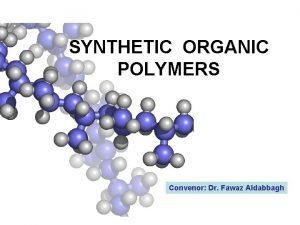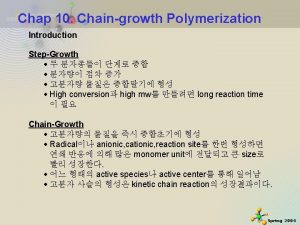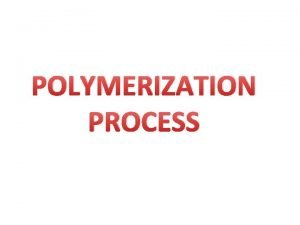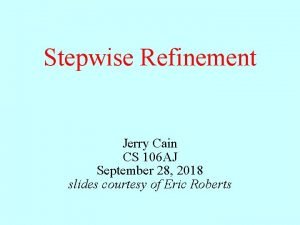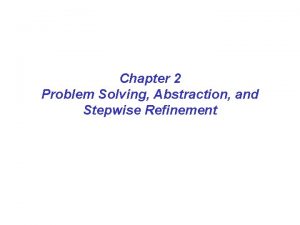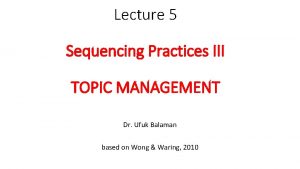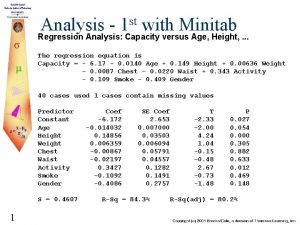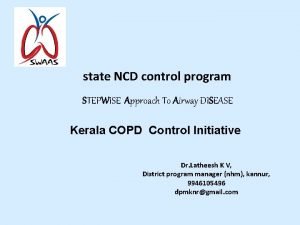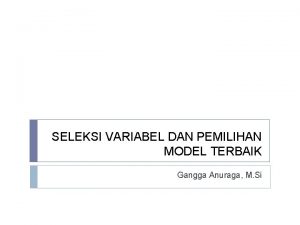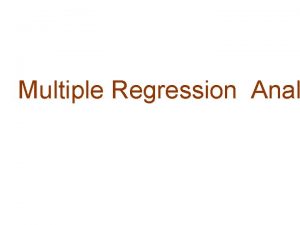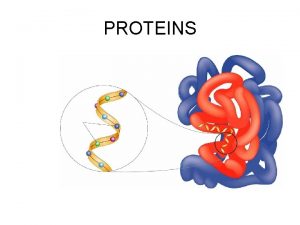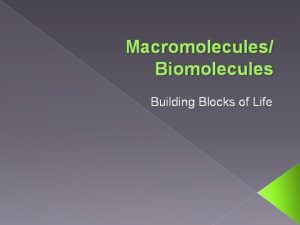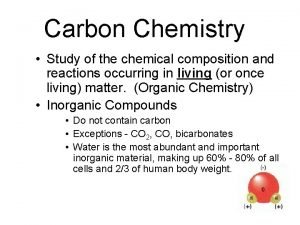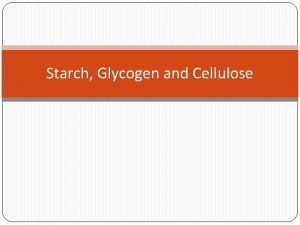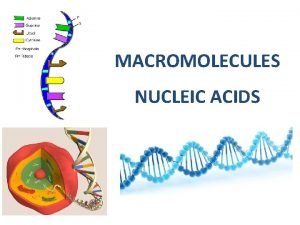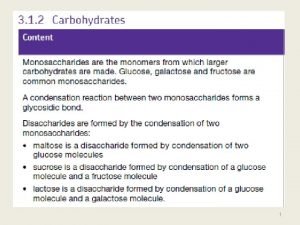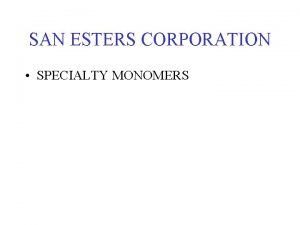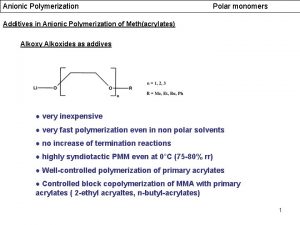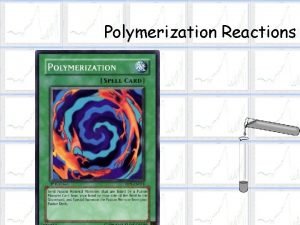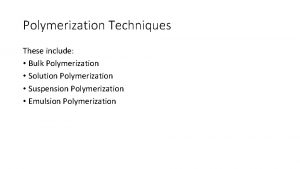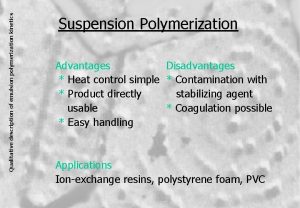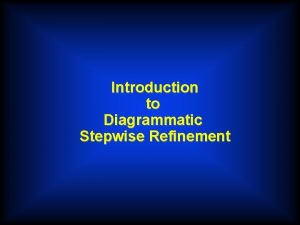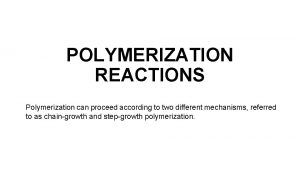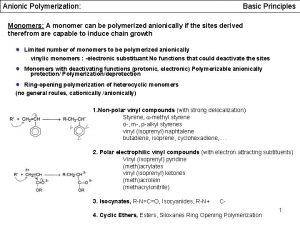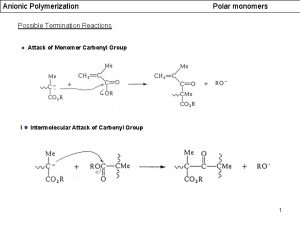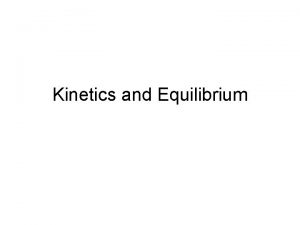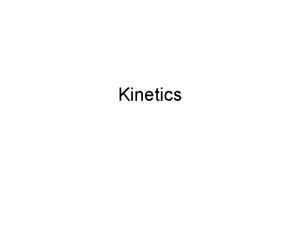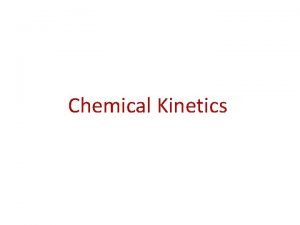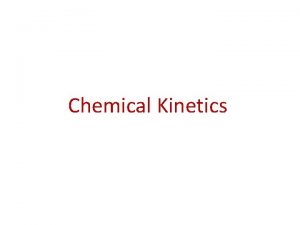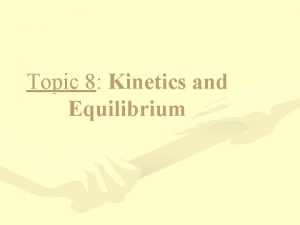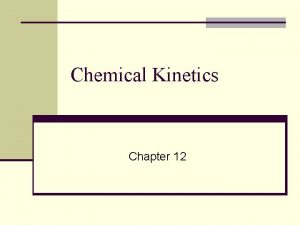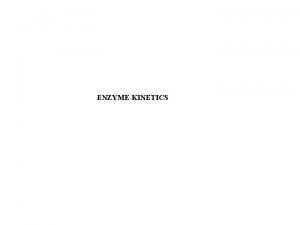Polymerization kinetics Stepwise polymerization any two monomers present













![• Michaelis-Menten equation can be obtained by plug the value of [ES] into • Michaelis-Menten equation can be obtained by plug the value of [ES] into](https://slidetodoc.com/presentation_image_h/d80a03252d1a37eec1064265d1e8494e/image-14.jpg)



- Slides: 17

Polymerization kinetics • Stepwise polymerization: any two monomers present in the reaction mixture can link together at any time. The growth of the polymer is not confined to chains that are already formed. • Chain polymerization: an activated monomer attacks another monomer, links to it, then that unit attacks another monomer, and so on.

23. 3 Stepwise polymerization • Commonly proceeds through a condensation reaction, in which a small molecule is eliminated in each step. • The formation of nylon-66 H 2 N(CH 2)6 NH 2 + HOOC(CH 2)4 COOH → H 2 N(CH 2)6 NHOC(CH 2)4 COOH • HO-M-COOH + HO-M-COOH → HO-M-COOH • Because the condensation reaction can occur between molecules containing any number of monomer units, chains of many different lengths can grow in the reaction mixture.

Stepwise polymerization • The rate law can be expressed as • Assuming that the rate constant k is independent of the chain length, then k remains constant throughout the reaction. • The degree of polymerization: The average number of monomers per polymer molecule, <n>

23. 4 Chain polymerization • Occurs by addition of monomers to a growing polymer, often by a radical chain process. • Rapid growth of an individual polymer chain for each activated monomer. • The addition polymerizations of ethene, methyl methacrylate, and styrene. • The rate of polymerization is proportional to the square root of the initiator concentration.

The three basic types of reaction step in a chain polymerization I → R. + R. vi = ki[I] M + R. →. M 1 (fast) (b) Propagation: M +. M 1→. M 2 M +. M 2→. M 3 ░ vp = kp[M][. M] M +. Mn-1→. Mn (c) Termination: Mutual termination: . Mn +. Mm→ Mn+m Disproportionation: . Mn +. Mm→ Mn + Mm Chain transfer: M +. Mn → M n +. M (a) Initiation:

Influences of termination step on the polymerization • Mutual termination: two growing radical chains combine. vt = kt ([. M])2 • Disproportionation: Such as the transfer of a hydrogen atom from one chain to another, which corresponds to the oxidation of the donor and the reduction of acceptor. vt = kt ([. M])2 • Chain transfer: vt = ?

• the net rate of change of radical concentration is calculated as • Using steady-state approximation (the rate of production of radicals equals the termination rate) • The rate of polymerization vp = kp[. M][M] = kp[M] • The above equation states that the rate of polymerization is proportional to the square root of the concentration of the initiator. • Kinetic chain length, v, • <n> = 2 v (for mutual termination)

• Example: For a free radical addition polymerization with ki = 5. 0 x 10 -5 s-1 , f = 0. 5, kt = 2. 0 x 107 dm 3 mol-1 s-1, and kp = 2640 dm 3 mol-1 s-1 , and with initial concentrations of [M] = 2. 0 M and [I] = 8 x 10 -3 M. Assume the termination is by combination. (a) The steady-state concentration of free radicals. (b) The average kinetic chain length. (c) The production rate of polymer. Solution: (a) (b) (c) The production rate of polymer corresponds to the rate of polymerization is vp: vp = kp[. M][M]

23. 5 Features of homogeneous catalysis • A Catalyst is a substance that accelerates a reaction but undergoes no net chemical change. • Enzymes are biological catalysts and are very specific. • Homogeneous catalyst: a catalyst in the same phase as the reaction mixture. • heterogeneous catalysts: a catalyst exists in a different phase from the reaction mixture.

Example: Bromide-catalyzed decomposition of hydrogen peroxide: 2 H 2 O 2(aq) → 2 H 2 O(l) + O 2(g) is believed to proceed through the following pre-equilibrium: H 3 O + + H 2 O 2 ↔ H 3 O 2 + + H 2 O H 3 O 2+ + Br- → HOBr + H 2 O v = k[H 3 O 2+][Br-] HOBr + H 2 O 2 → H 3 O+ + O 2 + Br- (fast) The second step is the rate-determining step. Thus the production rate of O 2 can be expressed by the rate of the second step. The concentration of [H 3 O 2+] can be solved [H 3 O 2+] = K[H 2 O 2][H 3 O+] Thus The rate depends on the concentration of Br- and on the p. H of the solution (i. e. [H 3 O+]).

• Exercise 23. 4 b: Consider the acid-catalysed reaction (1) HA + H+ ↔ HAH+ k 1, k 1’ , both fast (2) HAH+ + B → BH+ + AH k 2, slow Deduce the rate law and show that it can be made independent of the specific term [H+] Solution:

23. 6 Enzymes Three principal features of enzyme-catalyzed reactions: 1. For a given initial concentration of substrate, [S]0, the initial rate of product formation is proportional to the total concentration of enzyme, [E]0. 2. For a given [E]0 and low values of [S]0, the rate of product formation is proportional to [S]0. 3. For a given [E]0 and high values of [S]0, the rate of product formation becomes independent of [S]0, reaching a maximum value known as the maximum velocity, vmax.

• Michaelis-Menten mechanism E + S → ES ES →E + S ES →P + E The rate of product formation: k 1 k 2 k 3 To get a solution for the above equation, one needs to know the value of [ES] Applying steady-state approximation Because [E]0 = [E] + [ES], and [S] ≈ [S]0
![MichaelisMenten equation can be obtained by plug the value of ES into • Michaelis-Menten equation can be obtained by plug the value of [ES] into](https://slidetodoc.com/presentation_image_h/d80a03252d1a37eec1064265d1e8494e/image-14.jpg)
• Michaelis-Menten equation can be obtained by plug the value of [ES] into the rate law of P: • Michaelis-Menten constant: KM can also be expressed as [E][S]/[ES]. • Analysis: 1. When [S]0 << KM, the rate of product formation is proportional to [S]0: 2. When [S]0 >> KM, the rate of product formation reaches its maximum value, which is independent of [S]0: v = vmax = k 3[E]0

With the definition of KM and vmax, we get The above Equation can be rearranged into: Therefore, a straight line is expected with the slope of KM/vmax, and a yintercept at 1/vmax when plotting 1/v versus 1/[S]0. Such a plot is called Lineweaver-Burk plot, • The catalytic efficiency of enzymes Catalytic constant (or, turnover number) of an enzyme, kcat, is the number of catalytic cycles (turnovers) performed by the active site in a given interval divided by the duration of the interval. • Catalytic efficiency, ε, of an enzyme is the ratio kcat/KM,

Example: The enzyme carbonic anhydrase catalyses the hydration of CO 2 in red blood cells to give bicarbonate ion: CO 2 + H 2 O → HCO 3 - + H+ The following data were obtained for the reaction at p. H = 7. 1, 273. 5 K, and an enzyme concentration of 2. 3 nmol L-1. [CO 2]/(mmol L-1) 1. 25 2. 5 5. 0 20. 0 rate/(mol L-1 s-1) 2. 78 x 10 -5 5. 00 x 10 -5 8. 33 x 10 -5 1. 67 x 10 -4 Determine the catalytic efficiency of carbonic anhydrase at 273. 5 K Answer: Make a Lineweaver-Burk plot and determine the values of KM and vmax from the graph. The slope is 40 s and y-intercept is 4. 0 x 103 L mol-1 s vmax = = 2. 5 x 10 -4 mol L-1 s-1 KM = (2. 5 x 10 -4 mol L-1 s-1)(40 s) = 1. 0 x 10 -2 mol L-1 kcat = = 1. 1 x 105 s-1 ε= = 1. 1 x 107 L mol-1 s-1

Mechanisms of enzyme inhibition • Competitive inhibition: the inhibitor (I) binds only to the active site. EI ↔ E + I • Non-competitive inhibition: binds to a site away from the active site. It can take place on E and ES EI ↔ E + I ESI ↔ ES + I • Uncompetitive inhibition: binds to a site of the enzyme that is removed from the active site, but only if the substrate us already present. ESI ↔ ES + I • The efficiency of the inhibitor (as well as the type of inhibition) can be determined with controlled experiments
 Monomer and polymer
Monomer and polymer Step polymerization vs. chain polymerization
Step polymerization vs. chain polymerization Polymerization process
Polymerization process Stepwise refinement python
Stepwise refinement python Stepwise refinement definition
Stepwise refinement definition Stepwise topic shift
Stepwise topic shift Stepwise regression minitab
Stepwise regression minitab Stepwise airway management
Stepwise airway management Contoh stepwise
Contoh stepwise Contoh cross section
Contoh cross section Regression anal
Regression anal Protein monomers
Protein monomers Building blocks of macromolecules
Building blocks of macromolecules Monomers of lipids
Monomers of lipids Glycogen vs starch vs cellulose
Glycogen vs starch vs cellulose Nucleic acid building blocks
Nucleic acid building blocks Maltose formation
Maltose formation San esters corporation
San esters corporation
